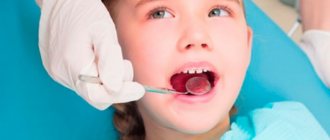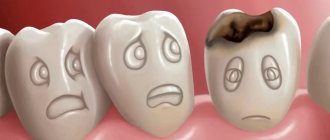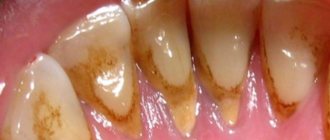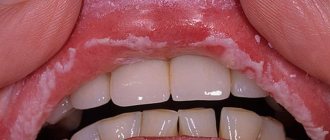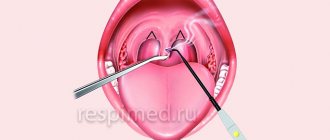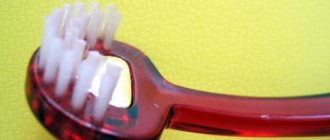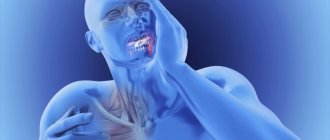Dentinogenesis imperfecta type I
Pathology is always combined with osteogenesis imperfecta. It occurs more often in men, frequency - 1:50,000. General clinical signs may vary depending on the type of inheritance. Teeth wear out quickly and become more intensely colored, and are sometimes affected by caries. In permanent teeth, the clinical picture varies. On examination, the bulbous shape of the teeth and root fractures are noticeable.
The diagnosis is confirmed by x-ray. The image shows thinning of the cortical layer of the jaw and the coarse structure of the spongy substance. After eruption, obliteration of the roots begins, which slowly progresses.
The main pathological signs are:
- normal enamel structure;
- enamel-dentin junction in the form of a straight line;
- a decrease in the number of dentinal tubules in the peripulp dentin, their uneven diameter, narrowing and obliteration;
- deficiency of dentin mineralization;
- absence of conversion of precollagen fibers into collagen fibers.
Diagnostics
Treatment of amelogenesis imperfecta is prescribed after a comprehensive examination. The disease is diagnosed by dentists. To establish and confirm the diagnosis, the dentist analyzes clinical signs, interviews the patient, studies the history of the pathology, examines the oral cavity, and gives a referral for radiography. Usually, the picture shows that there are no pathological changes in the pulp chamber or root canals. Dystrophic phenomena can cause obliteration of the canals.
Hypomaturation leads to expansion of the pulp chamber, and a short root is diagnosed. Additionally, the patient is recommended to make an appointment with a genetic specialist. It is important to distinguish abnormalities from fluorosis in order to avoid incorrect treatment. If the enamel layer is normal, it has a high degree of radiopacity when compared with dentin. When the hypomaturation type of the disease is detected, dentin and enamel have equal contrast. When dentin is hypomineralized, the contrast is higher. The hypoplastic form is determined by a thin enamel layer. The doctor also pays attention to the following factors: tetracycline teeth, disturbances in the metabolism of phosphorus, calcium, syndrome of reduced mineralization of incisors and molars.
Type II dentinogenesis imperfecta
This pathology is otherwise called hereditary opalescent dentin, or “crownless teeth.” It occurs with a frequency of 1:8000, develops in an autosomal dominant pattern and has another name: Stainton-Candepont syndrome. As a rule, the disease is not combined with general diseases.
The enamel turns watery gray, amber or purple-blue, and the teeth become translucent. Sometimes the crowns take on a purple hue and are shaped like an onion. 2-4 years after teething, the enamel begins to actively chip off. The occlusal surface of the teeth is characterized by increased abrasion, and exposed dentin turns brown.
Additional clinical signs include increased electrical excitability of the pulp and a possible delay in root resorption of primary teeth. In some patients, on the contrary, early replacement of milk teeth with permanent teeth is observed, and caries is rare with this pathology.
X-ray signs:
- the roots may be shortened, with hypercementosis, with foci of clearing in the apical area;
- dental cavities are reduced, the canals are narrow or obliterated, which is a consequence of progressive calcification;
- the height of the crowns is reduced due to rapid abrasion;
- There are areas of rarefaction of bone tissue in the area of the root apexes.
Pathomorphological features:
- The structure of the enamel is disrupted, the tissue becomes thinner, the number of organic plates increases, and areas of structureless enamel are noticeable.
- At the enamel-dentin junction there is a straight line.
- The structure of dentin is heterogeneous.
- The number of tubes in the peripulpar dentin is reduced; they are short, curved, expanded and grouped in several pieces.
- The amount of interglobular dentin increases.
- In dentin, the amount of mineral substances decreases (60%), while the amount of water (25%) and organic substances (15%) increases.
- Hydroxyapatite crystals are replaced by an amorphous structure.
- The dentin matrix has an atypical structure, and predentin is expanded.
- The number of odontoblasts decreases, the shape of the cell and nucleus changes, processes are absent, and in some cases the odontoblasts themselves are absent.
- The pulp has few vessels, but many denticles and fibers.
- Degenerative changes in the cement are noticeable.
Forms of anomaly
Dentin pathology can be of three types:
- The first type is caused by a lack of collagen.
- The second type of anomaly is diagnosed more often than others. The provocative factor is the DSPP gene mutation (dentin sialophosphoprotein gene). It is he who plays a key role in the formation of matrix protein tissues.
- The reason for the development of the third type is a violation of the matrix dentin phosphoprotein.
The first type of pathology is characterized by dysplasia of the hard matter of the periodontal primordia, while the second type of lesion affects the coronal part. Regardless of the form of the disease, the surface tissues of dentin remain in normal condition.
Clinical picture
The symptoms of dentinogenesis imperfecta depend on its form.
The following are considered characteristic signs of abnormal dentin development:
- bluish color of the enamel, gradually changing to gray-brown;
- local hemorrhages;
- fragility of hard tissues;
- abnormal shape of the middle ear.
The first form of pathology is characterized by the following symptoms:
- normal shape of the tooth surface;
- narrowed dentin tubes;
- collagen deficiency;
- jaw mobility;
- bow-shaped crowns (rare);
- intensive abrasion of enamel;
- hypomineralization of tooth tissue.
The second type is accompanied by the following symptoms:
- destruction of the tooth surface;
- gradual destruction of dental cement;
- heterogeneous dentin structure;
- insufficient amount of mineral elements in damaged tissues;
- intense calcification of the pulp chamber;
Diagnostics
Pathology is identified based on accompanying symptoms. In particular:
- fibrous destruction of the dentin matrix;
- enlarged pulp chamber;
- bell-shaped crowns;
- multiple openings of the pulp chamber;
- heterogeneity of dentin tissues located near the affected area.
The complication of the pathology leads to a gradual darkening of the enamel. The thinning of the enamel is accompanied by dentin exposure, as a result of which it loses its protective coating. As a result, the patient experiences discomfort when the tooth comes into contact with cold and hot food, as well as during brushing.
Dental treatment
Taking into account the fact that dentinogenesis imperfecta is of genetic origin, it cannot be completely eliminated. The patient is prescribed a set of measures to strengthen the enamel, such as:
- remineralization;
- taking medications containing calcium and fluoride;
- installation of artificial crowns on problem areas;
- the use of removable orthopedic structures to eliminate or prevent subsequent deformation;
- composite restoration;
- installation of removable aligners to normalize the bite.
Diagnosis of the disease in the early stages allows you to avoid damage to the dentition.
Methods of modern medicine
As a rule, treatment of genetic dental disease (amelogenesis imperfecta) lasts at least a year.
The treatment protocol may include the following:
- applications with fluorine-containing and calcium-containing preparations at intervals of three months;
- the use of amorphous calcium phosphate, casein phosphoprotein;
- restoration of teeth and installation of dentures when significant lesions are identified;
- installation of artificial crowns.
The result directly depends on timely contact with the dentist and appropriate therapy. Despite the fact that hereditary pathologies cannot be cured completely, modern therapy can minimize significant discomfort for patients.
Type III dentinogenesis imperfecta
This form is rare and is considered an isolated hereditary form of wine opalescent dentin. With it, the crowns of the teeth take on the shape of a bell. Multiple openings are noticeable in primary teeth. The x-ray shows a contrasting contour of the tooth with internal enlightenment. This is explained by the fact that after the formation of the outer covering layer, dentin production ends.
Symptoms
Symptoms largely depend on the category of pathology:
- If the patient suffers from the first form, his units erupt in time and are of normal size. But the patient complains of bleeding gums, as well as mobility of the chewing organs. Its dentin has a pronounced gray-watery color. Sometimes crowns resemble the shape of onions. A high degree of enamel abrasion and root fractures are often diagnosed.
- The second form of pathology has an isolated character. Dental tissues are stained amber or have a gray-watery tint. Less commonly, chewing organs are purple in color. Sometimes the crowns become short and have an onion-like shape. A distinctive feature is the progressive obliteration of the pulp chambers, which forms before the units erupt. If a chip appears on the crown, the dentin quickly becomes exposed, the height of the bite decreases, and the head in the temporomandibular joint shifts. Gradually, the teeth acquire a brown tint. At the same time, the roots become thinner and curved. Additional signs: high degree of electrical excitability of the pulp, delay in temporary organs of root resorption. But, in some patients, the change of milk units occurs ahead of schedule. In such a situation, caries rarely occurs.
- The third type is distinguished by the fact that the permanent masticatory organs are bell-shaped. Their color is brownish-yellowish or bluish-gray. Typically, in this situation, the pulp chambers are characterized by multiple openings.
It is useful to remineralize teeth. During fluoridation, the enamel is saturated with mineral elements. This technology restores the structure of the crown. The procedure can be artificial or natural. In the latter case, the enamel is restored due to the patient’s nutritious diet and taking vitamin and mineral complexes. With the artificial technique, the enamel is covered with protective compounds that include fluoride or mixtures without fluorides.
Treatment of dentinogenesis imperfecta
Unlike the treatment of pulpitis of baby teeth or caries, with this diagnosis, mainly orthopedic rather than therapeutic dentistry is possible. If the primary teeth are completely worn down, complete plate-type dentures are made and placed over the roots. With their help, they monitor the functional load when chewing, and also provide optimal conditions for changing the bite to a permanent one. The prosthesis also maintains the myodynamic balance of the masticatory muscles, the height of the bite at the beginning of its formation, and compensates for aesthetic defects.
If the teeth are not completely worn down, individual thin-walled stamped crowns are made to maintain the height of the bite. They also cover permanent molars and incisors that have just erupted. These actions are aimed at stopping the abrasion of hard tooth tissues and increasing the height of the bite.
Once the permanent teeth have fully erupted, the temporary crowns are replaced with permanent ones. Due to obliteration of the root canals, the manufacture of pin structures is excluded, however, parapulp pins and composite materials can be used to build up missing tissues before prosthetics.
Causes
An anomaly appears when there is a disturbance in the development of hard dental tissues. The patient develops amorphous, disorganized, atubular dentin with a high content of organic microelements. The first category of disease is characterized by a lack of collagen. In the second type of disease, the main provoking factor is a defect in the DSPP gene. The provocateur of the third type of pathology is a violation of the phosphoprotein matrix, which is part of the hard tissues of the masticatory organs. In newborns (1 case per 17.5 thousand), the disease has a hereditary factor.
The mechanism of infection can be autosomal dominant, recessive or non-mutational. The genetic risk of the lesion is 50%. To identify the cause of the anomaly and develop the correct treatment plan, it is better to contact a private dental clinic. Only qualified specialists will be able to understand this issue. Self-medication is unacceptable. After all, such heterogeneous genetic damage can combine several diseases with different etiologies, which have the same clinical picture.
Prevention of fluorosis
The only possible way to prevent and prevent further development of fluorosis is to stop drinking water with a high fluoride content; in case of severe air pollution, move to another area. Fortunately, in Russia, only 2-3% of the population lives in areas where fluorosis is endemic (that is, in areas where the fluoride content in water can cause the development of fluorosis in children and adolescents). In the Leningrad region this is the Volkhov district.
make an appointment with a pediatric dentist online or by phone: +7(812)3310000
Anatomical dental pathologies
Dental anomalies are deviations from the physiological norm in the size of teeth, their number, color, shape, structure of hard tissues, timing of eruption, position in the dentition. All these pathologies are associated with improper formation of the dentofacial apparatus and are accompanied by aesthetic defects, deformation of the maxillofacial area, malocclusion and diction, and difficulties in chewing food.
Edentia
Adentia is the partial or complete absence of teeth as a result of disruption of their formation.
If you do not seek dental help when symptoms of partial edentia are detected, the jaw will begin to deform and malocclusion will develop. The complete absence of teeth will lead to gastrointestinal diseases, poor functioning of the body as a whole and impaired quality of life.
Dystopian teeth
Teeth that are incorrectly positioned in the dental arch are called dystopic, and the anomaly of such teeth itself is called dystopia.
Displaced teeth significantly spoil the aesthetics of a smile and lead to disturbances in the functioning of the maxillofacial area, the masticatory apparatus and complications: the occurrence of caries, periodontitis, ulcers on the oral mucosa, inflammation of the soft tissues around the erupted tooth.
Impacted teeth
Tooth retention is a delay in the eruption of a fully formed dental unit.
An impacted tooth contributes to the development of dental defects, chronic gum diseases, and the appearance of cysts. In this regard, retention requires mandatory orthodontic and surgical treatment.
Hyperdontia
Hyperdontia (polyodontia) is an anatomical anomaly manifested in the presence of supernumerary teeth.
Supernumerary teeth cause various anomalies of the dental system and inflammatory-dystrophic changes in the surrounding tissues. Often due to hyperdontia, malocclusion is formed, speech defects appear, and the eruption of permanent teeth is delayed.
Microdentia
Microdentia is an anomaly in which the teeth are significantly smaller than their anatomically normal size.
Pathologically small teeth differ from anatomically normal ones by at least 1.5 mm in both diameter and height. Because of this, gaps form between the teeth, which can subsequently lead to periodontal tissue diseases.
Macrodentia
Macrodentia is an anomaly of teeth in which their crown part is significantly larger than the anatomically normal size.
Disproportionately large teeth contribute to deformation of the bones of the facial part of the skull and malocclusion. The person experiences psychological discomfort. The consequences of macrodentia can be successfully eliminated using modern orthodontic methods.
Amelogenesis imperfecta and dentinogenesis
Amelogenesis imperfecta is a rare hereditary anomaly of enamel formation, which manifests itself already at the stage of intrauterine development. The disease usually accompanies dentinogenesis, a genetic pathology of dentin formation.
If teeth affected by imperfect amelo- and dentinogenesis are affected by caries, it will begin to spread quickly, since the enamel and dentin layers are weakly connected.

